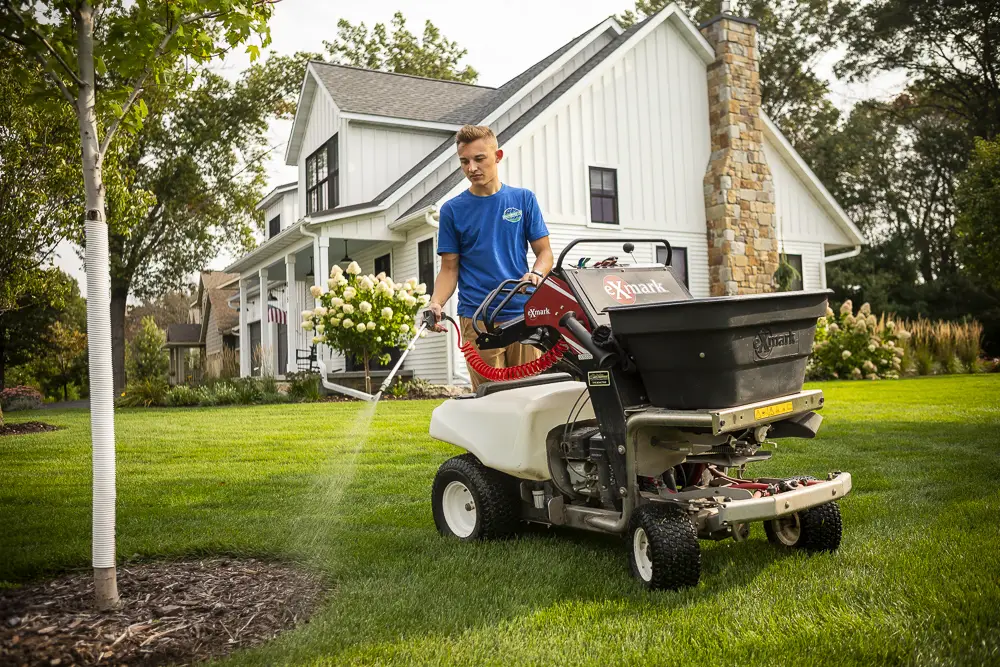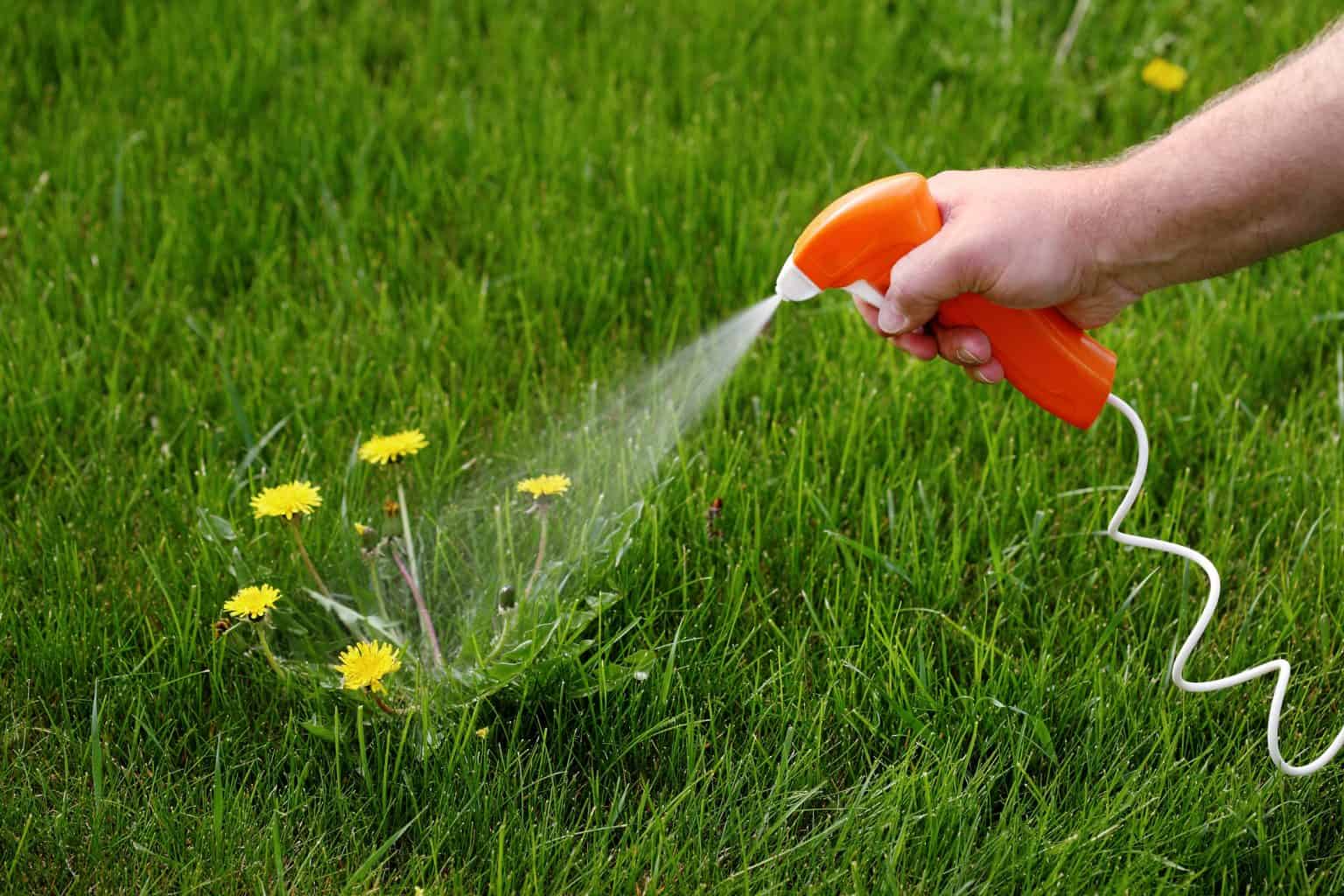Applying Weed Killer To A New Lawn
New lawns are more sensitive to herbicides than established lawns. Don’t apply pre-emergent weed killer to a newly seeded lawn. When the grass has an established root system, you can safely apply a pre-emergent herbicide product that contains dinitroaniline. Additionally, in spring, you can apply a product that contains pendimethalin to a lawn that was seeded in fall, after the lawn has been mowed four times.
When applying a post-emergent herbicide to a new lawn, again, wait until the lawn has been mowed four times. If the lawn is newly sprigged, wait until the sprigs are rooted and growing. Apply the weed killer at half the rate recommended on the label, and reapply the product seven to 10 days later to treat weeds that may have survived the first application.
Ive Created This List As A Guideline To Follow When Spraying For Weeds
Rule 1. Identify the weed and make sure you are buying the appropriate herbicide.
If you bring a sample of the weed you are trying to control, someone at the store will likely be able to help you find the correct herbicide.
Rule 2. Make sure you are using a spreader sticker.
A spreader sticker is a liquid additive that you mix with the weed killer and water. It helps the herbicide stick to the leaves more effectively, thus having better results. I know it may just seem like more money being spent, but it usually doesnt cost but a few dollars and it really does make a difference.
Rule 3. Make sure you follow the instructions on the label.
When spraying for weeds, you must absolutely read the label before mixing/spraying the weed killer. The label will tell you things like what kind of clothes to wear while spraying for weeds, what the temperature should be when spraying for weeds, what rates to mix the weed killer with water and how often you can spray your lawn with that particular product.
Rule 4. Avoid overlapping so that you dont burn the grass.
If you overlap too often when spraying for weeds, you risk damaging the lawn and potentially killing your desirable grass. You might consider using a marker dye to see where you have already sprayed. Certain retail
Rule 5. Remember that most herbicides wont work when the soil temperature is very cold.
How To Spray Weed Killer
Everything will go in vain if you become unable to spray the weed killer properly. Hence, you must know the process of spraying herbicide on the garden. The step-by-step guides are given below.
- At first, you have to wear protective equipment, especially goggles, gloves, a long-sleeved shirt, and many more.
- Every weed killer has a distinctive using procedure, so you have to read the instruction carefully.
- Then manage a tank and store the calculated amount of herbicide into the tank.
- Always use the correct nozzle application by following the product label.
- Spray herbicide when the air is calm and follow caution when spraying weeds.
- Always create targeting spraying areas so that other plants wont become affected.
- Avoid walking in a large area and dont dump rinse water on the hard surface.
- For better results, spray one weed growing in the middle of the intended plant.
Final Thought
You will get rid of irritating weeds whenever you can apply the weed killer appropriately. Along with choosing the effective herbicide, its also crucial to know the appropriate time of spraying.
From this article, you obviously have been informed about the best time to spray weed killer. If you can apply the weed killer in those mentioned times, you will find the prospected result. And ultimately, you can have extraordinary growth of plants in your garden.
Recommended Reading: What Kills Ferns
How Long To Stay Off Lawn After Weed And Feed
You should be good to use your lawn again after 24-72 hours. This give the fertilizer time to work its way into the soil. See the paragraphs below for when to water after application.
As always, we would recommend that you read the manufacturers directions included on the packaging. .
You should also not carry out aerating after weed & feed application, as it can possibly damage any new emerging grass seedlings.
Can I Implement Weed Control On My Own

Now that you understand how these products work and what you can expect out of them, you might be wondering whether you can just implement a DIY program. After all, there are weed control products sold at the big box stores.
While theres certainly nothing stopping you from handling weed control on your own, youre not going to get as good results as you would with a professional program for several key reasons.
- Product effectiveness: The weed control products sold at the store to homeowners are simply not as good as the professional-grade products used by a licensed technician.
- Being able to mix products properly: Many times your professional lawn care technician will mix products together in order to give you the best possible combination. Homeowners likely dont know which products to mix nor would they want to be dealing with mixing product at their home. There are also some additives that professionals will use at times for better results. For instance, Master Lawn adds surfactants, which is a wetting agent that helps materials not to bead up and roll off of leaf blades. This enhances results for some weeds.
Also Check: Where Are Cub Cadet Lawn Mowers Made
Different Methods Of Application
Ortho essentially packages the same chemicals in each of two primary weed-killer products with several application choices:
- Chemicals that you have to dilute by mixing them in water using a tank sprayer or an Ortho Dial N Spray that you connect to your garden hose are available as concentrate.
- Premixed/prediluted chemicals that you apply with a flexible hose and attached sprayer are available as ready-to-use products.
- Premixed/prediluted chemicals that come in a smaller spray container for spot-treating weeds are available as ready-to-spray products.
How To Control Weeds In A Newly Seeded Lawn
However, you can get rid of these weeds just as fast as they have appeared.The important thing to remember when new weeds appear in your newly sown lawn is not to act hastily do not apply a Feed, Weed and Moss Killer type product of any kind on a newly sown lawn.
Although this can be frustrating and we can appreciate that a quick solution will be desired, the good news about these types of weeds is that they are largely shallow rooting and should come out with the first mow at the 6-8 week mark after sowing. If they dont, they should be easy to pull out of the turf.
If you find that the weeds are recurring past the 6-8-week mark, you may wish to consider using a selective herbicide to spot spray your weeds. Some weed killers such as glyphosate kill more than just weeds, so it is important to not apply these as if they are not done precisely, they can kill your grass. Shop bought selective weed killers will recommend when to apply their product and how often and you should read the instructions thoroughly and adhere to them.
In short, here’s what you should do if you encounter weeds in your newly seeded lawn:
Read Also: Oil Change For Craftsman Lawn Mower
How Long Does Pre
If properly applied and watered into the soil, pre-emergent herbicide lasts 6-8 weeks. That means that for up to 2 months, any weeds that try to sprout in your lawn will be killed as they germinate.
To ensure maximum effectiveness of your pre-emergent, spread your weed killer at concentrations recommended by the manufacturer, using a sprayer or a drop spreader .
For longest-lasting results, after application, water the pre-emergent into your soil with 0.5 inches of water. Thats about half an hour of watering with a sprinkler. If you dont have a watering system, plan to spread your pre-emergent 2448 hours before rainfall and let nature do the watering. By watering pre-emergent into the soil, you ensure it forms a barrier beneath the surface to stop those sprouting seeds.
When Should I Apply Tenacity To My Lawn
4.4/5Applying Tenacitywillgrasscanshouldon it here
Answer: You can apply Tenacity Herbicide multiple times per year as long as you do not exceed the maximum annual rate of 16 oz per Acre per year. To treat yellow nutsedge, you may need to reapply Tenacity after 2 to 3 weeks be sure to use a non-ionic surfactant for post-emergent applications.
Additionally, does tenacity need to be watered in? Re: Watering in TenacityWhen used as a postemergent, susceptible weeds absorb Tenacity through foliar contact and soil absorption. Therefore, you should water in Tenacity when using it as a preemergent herbicide but it does not need to be watered in when using it as a postemergent herbicide.
Hereof, what temperature should you use tenacity?
Answer: Tenacity Herbicide should not be applied to the lawn when temperatures are over 90 degrees or on day when you are expecting rainfall.
How quickly does tenacity work?
two to three weeks
Recommended Reading: What Does Peat Moss Do For Grass
When Is The Best Time To Apply A Broadleaf Herbicide To The Lawn
Fall is the best time to control perennial broadleaf weeds in the lawn with broadleaf herbicides. In fall, perennial broadleaf weeds are transporting food from their foliage to their roots in preparation for winter. Broadleaf herbicides applied in fall will be absorbed by the broadleaf weeds foliage and transported to the roots along with the carbohydrates, resulting in the destruction of the broadleaf weeds. Spring applications are less effective than fall applications.
How Often Does My Lawn Need Feeding And Treatments For Weeds
- The current condition of the lawn
- The soil beneath it. How deep is it, whats its composition?
- The grass species within the lawn. Robust ryegrasses or shallow rooted fine grasses?
- Sunlight and shade
- Weather
- The microclimate
- How much wear and tear the lawn has and whether its used by pets and children
- Mowing regime very close mown lawns need more treatments than slightly longer grass
- The area beyond the garden could seeds blow in from neighbouring fields? Is there a lot of pollution from traffic? Is it visited by wildlife?
Don’t Miss: Trade In Lawn Mower
When And How To Fertilize New Grass
If you’re starting a new lawn from seed, sod or plugs or you’re doing bare lawn spot repair a starter fertilizer helps grass get the perfect start. Unlike established lawns, new grass benefits from extra phosphorus, an essential plant nutrient that supports strong, deep roots. Some states only allow phosphorus-containing lawn fertilizers on new grass, so check with your county extension office if you’re unsure.
On fertilizer products, phosphorus is the middle number in the N-P-K ratio usually “0” in normal lawn fertilizers. But with Pennington UltraGreen Starter Fertilizer 22-23-4, you get an ideal ratio of nitrogen, phosphorus and potassium, plus other essential lawn nutrients, including iron for deep green color. This premium fertilizer blend starts feeding new grass immediately and keeps feeding it for up to three months.
Always follow guidelines for the best time to plant grass seed for your region and grass type, then fertilize accordingly. For seed or plugs, apply fertilizer with a regular lawn spreader before you plant. If you’re starting a lawn with sod, fertilize after your sod is in place.
With any new lawn area, avoid using crabgrass preventer fertilizers or weed & feed fertilizers within four weeks before planting time. After seeding, wait until your new grass gets established and you’ve mowed your lawn at least three times.
Weed & feed fertilizers kill tough weeds and feed your lawn.
When To Apply Spring Pre

Spring pre-emergent weed killers are designed to stop invasive grasses, such as crabgrass and foxtail, as well as spring weeds like dandelions. To get the timing right, wait until soil temperatures have been at 55 for 23 days. Check soil temperature by viewing a local soil temperature map online or through the use of a soil thermometer.
The reason temperature is so important is because warming soil triggers weed seeds to germinate. Crabgrass and foxtailtwo of the most common weeds in North Americagerminate soon after soil temperatures reach 55, with other weeds following closely behind. By applying pre-emergent once soils consistently reach this temperature, you will stop the widest range of weeds.
You May Like: How To Get Rid Of Geese On Lawn
How Long Does Weed Killer Work
While certain weeds are easy to control and can be knocked back with just one treatment, other weeds are a bit more persistent and may require multiple treatments. While we wish we could say that once we treat weeds, theyll never return, thats simply not the case.
Some of the more aggressive weeds, particularly grassy weeds do continue to return and require ongoing treatment. Fortunately, when youre on a comprehensive lawn care program, the goal is to stay ahead of these weeds and to use pre-emergent as effectively as possible. Then, we only have to spot-treat the breakthrough that pops up with post-emergent, selective materials.
Types Of Different Weed Killers: How To Apply Them At The Proper Time
Herbicides are recognized either as pre-emergent or post-emergent. Post-emergent herbicides, which may be systemic or non-systemic, are used to control existing weeds. Herbicides that pass through vegetation to the roots are known as systemic herbicides, and theyre most successful while the plants are actively developing.
Plant tissues are damaged by non-systemic herbicides, which can be spread at any time of day. Pre-emergent herbicides may be used at any time of day and are still effective. This herbicide works by forming a chemical membrane in the topsoil that keeps weeds out.
1) When to apply a systemic herbicide
Systemic weed killers are most effective throughout the planting season, and they are ineffective after the weeds have finished growing and gone dormant. The efficacy of systemic herbicides is increased when they are applied at peak plant growth periods during the day. Plant development speeds up and reduces during the day, based on the amount of sun, temperature, and environment.
In warmer climates, such as the U.S. Department of Agriculture plant hardiness zones 9 and higher, the safest hours to apply systemic herbicides in the summer are early morning and late afternoon. In the season, avoid using herbicides during midday or early afternoon. Plant development slows during the midday sun, and herbicides soon dry out on the plants, decreases the quantity of herbicide that weeds absorb.
2) When to apply herbicides for broadleaf weeds
Recommended Reading: What Is The Best All Wheel Drive Lawn Mower
Follow The Instructions To Treat Weeds
Not all weed treatments are created equal. Make sure that you thoroughly read and understand the instructions that your weed killer comes with. Some chemicals could prove to be hazardous to your lawn or your pets. Some killers can be used multiple times on the same patch of land with no negative side-effects, while others are strictly one-use only.
Too Much Weed Control On Lawn: Gypsum And Cgm
Gypsum, although a very effective soil quality enhancer, has a couple of weak points. One of the weak points is that it plays a role in changing the soil chemistry completely.
So, though it brings back the surface to its original state, you shouldnt use it without a proper soil test.
As for CGM or Gluten meal, it can be an effective natural solution to fertilizer burn. But, due to the high cost and selective nature, its not the greatest alternatives out there.
Our Favorite CGM/Gluten Meal: Gerbs Ground Pumpkin
Recommended Reading: Japanese Lawn Mowers
When You Should Spray Your Weeds
The best time to treat weeds is when they are actively growing. This means you should start spraying and treating in the spring, usually sometime in April. Youll have to maintain your weed-killing regiment into late September/early October.
Its best not to jump the gun when using weed killers. Theres a lot of weeds in early spring that wont surface until later on in the year. Most weed killers are contact sprays: The treatment will only be effective if they make direct contact with the weeds. Youre better off waiting until May: By that time most of the weeds will have emerged, making them much easier to dispose of.
When And How To Fertilize Your Lawn
In some ways, lawns are a lot like people. Operating at the peak of beauty and performance requires a good diet and proper care. Lush, thick, green lawns depend on properly timed, properly balanced nutrition to look and grow their best. Understanding when and how to fertilize your lawn can help you and your grass stand out from the rest.
Read Also: How Much Does Trugreen Lawn Service Cost
What Is The Best Time Of Day To Apply Weed Killer
The best time of day to apply a weed killer treatment is in the late morning or early afternoon. It helps prevent rapid evaporation before the weed killer can actively absorb into the dirt and start to kill the weeds.
A late afternoon treatment can also be effective, as long as it is not too hot or too cold.
View this post on Instagram
When To Apply Weed And Feed

Knowing when to weed and feed is essential, but before applying the best weed and feed, it is important to identify your type of grass, because some solutions can be applied to all lawn types, and others are designed for certain types of grasses and weeds. If you apply the wrong product to the wrong grass and weeds, then damage to your healthy grass and lawn is inevitable.
Don’t Miss: How To Kill Wild Violets In Lawn
